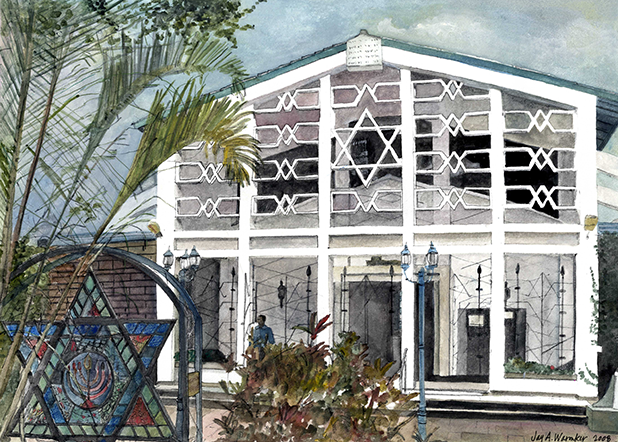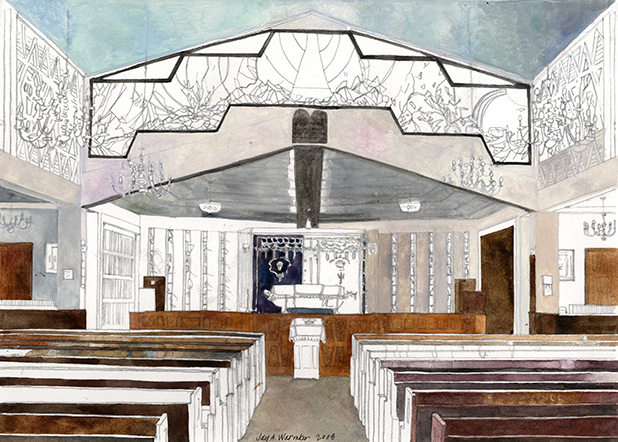 Exterior View (2008), 15” x 11” Watercolor, Jay A. Waronker
Exterior View (2008), 15” x 11” Watercolor, Jay A. Waronker
kenya
Nairobi Hebrew Congregation (Founded in 1907) Synagogue (First Building Dates to 1912; Current Building Completed in 1955) |
|

Interior View (2008), 11” x 15” Watercolor, Jay A. Waronker
|
Kenya’s Jewish community in Kenya dates back to the turn of the twentieth century when, in 1903, the British colonial secretary Joseph Chamberlain offered the Zionists a part of the territory in Kenya and Uganda known as the Uganda Program for their own autonomous country at the Sixth Zionist Congress. Whereas the proposal created much controversy among the international Jewish community, and was it eventually reverted at the Seventh Zionist Congress in 1905, several Jewish families nonetheless immigrated to Kenya and came to organize themselves into a formal community. It was in 1907, during a meeting of Jews, that the community gave itself the official name of Nairobi Hebrew Congregation and Burial Society. In 1908 the National Hebrew Congregation bought a large plot on what was then the western edge of the little dirt-road town, at the junction of Kirk Road and Charing Cross. This area was later reconfigured, and the property became bordered by Uhuru Highway at the juncture with University Circle. It came to be referred to as “God’s Corner” because nearby is the Catholic St. Paul’s Chapel and the Lutheran Church, while just beyond is the First Church of Christ Scientist, the Presbyterian St. Andrew’s Church, and the Freemasons Lodge.
The building of the synagogue was put out for tender, and according to synagogue records the contract went to an Englishman over a more expensive prominent Parsi contractor. The foundation stone was laid on June 20, 1912 by the Acting Governor of the East Africa Protectorate, Charles Calvert Bowring. By the end of that year, the building was ready to be used.
All thirty of Kenya’s Jews at the time attended the synagogue’s opening ceremony. While it was completed in December 1912, according to its history the initial service seemed to not be held there until the High Holidays the following year for whatever reason. At that time it became the first synagogue in East Africa. The synagogue as realized, a period building that is stylistically not pure and is difficult to categorize or label, was a chunky gabled single-story structure. It was detailed with corner quoins and a classically-inspired front entrance, a squat corner tower finished in the same stucco finish. The two towers were also capped with a shallow vaulted roof. The building, set within a natural park-like setting, was lovingly used throughout the first half of the twentieth century.
World War II bolstered the Kenyan economy with a modest post-war boom. This opened up many opportunities particularly in the national capital, and Jews from other parts of Kenya and elsewhere moved in Nairobi to take advantage of the strong economy. Although not a huge growth spurt, the influx of new Jews to the city in the late 1940s and early 1950s led to the community (one that never exceeded two hundred members) outgrowing the synagogue. The original building was also not in the best condition according to synagogue records.
Through membership subscription and a loan secured by members of the congregation, enough funds were raised to build a new larger synagogue. The building was designed in a Modern aesthetic in vogue at the time by Imre Rozsa, a Jewish architect who had a practice in Nairobi. In May 1954, a bid in the amount of £16,000 was accepted for the construction of the synagogue, and it was built on existing congregational property. On June 8, 1954, the last prayer service was held at the old synagogue before it was demolished to make room for the new building. Its foundation stone was set by the then-Governor and Commander in Chief of the Colony and Protectorate of Kenya, Sir Evelyn Baring on October 28, 1954 as witnessed by the members of the Nairobi Hebrew Congregation along with several invited guests from the local religious and secular communities. The construction of the synagogue was carried out by a local Jewish contractor, H. Groner with a Sikh foreman Mr. Singh.
Consecration of the new building took place on September 11, 1955. The building’s façade is made up of with double-height central gabled massing decorated with a large Star of David in the center of a screen wall. This screen wall is finished in white exterior plaster. The large central building massing is flanked by matching lower side wings veneered in local stone. These side bays are flat roofed. The recessed front porch of the synagogue, approached via broad steps that lead past a row of plain rectangular columns finished in white exterior plaster, features dedication and historical plaques along its walls. This ceiling of this entry space also features small domes.
The interior of the synagogue is made up of large sanctuary space measuring 55’ wide x 46’-6” deep. This space is in turn subdivided into a nave that is 39’ wide separated by low walls from side aisles each 7’-5” wide. Off the nave to the north is another area, raised off the main floor level by a couple of feet, where the pulpit, bimah (table where the Torah is read), and ark are positioned. This area is sandwiched between a storeroom to the west side and an office or gathering room to the east.
The most prominent architectural features of the sanctuary are the angled stained glass windows along each side, the window above the entrance, and the full-width stained glass window unit along the north elevation above the Ark. These windows, which capture in pattern and various colors various Jewish themes including the twelve ancient tribes, were not original to the sanctuary but added to the space only in the early 1990s. Fabricated by Bernhard Viehweber, a Germany master glass craftsman who had arrived in Nairobi in 1990, the windows were sponsored by individual members of the synagogue or by families. Along the southern elevation of the sanctuary is a remnant of the 1912 synagogue – a twin pairs of wood columns and an arched wood lintel once used at the sanctuary’s pulpit and Ark. The ceiling in the space is a shallow gable finished in white plaster, and the nave floor, finished in linoleum tiles, is filled with long wooden and leather padded pews. The sanctuary’s side aisles used exclusively for circulation have wood parquet floors, the pulpit is carpeted, and the walls of this space are plastered and painted white.
The architect’s wife, Lisa Rozsa, was responsible for upgrading the generous grounds of the synagogue campus, which along with the sanctuary building included some existing buildings used for administrative, educational, and social activities. Rozsa is accredited for transforming the synagogue property into a well-planned garden, providing a place of beauty and respite surrounded by the noise and urban concrete clutter of innermost Nairobi. To this date, the park-like quality of the Nairobi Hebrew Congregation campus continues.
In recent years the makeup of the Nairobi Hebrew Congregation had changed from those that settled in Kenya during colonial days or their native-born descendants to majority Israelis who moved to the city for work purposes and business opportunities.
The Jewish community in Kenya, a true microcosm of the Jewish Diaspora, has long been particularly diverse, comprised of not only Sephardim and Ashkenazim but of Jews from countries as diverse as Russia, Latvia, Lithuania, Poland, Romania, Czechoslovakia, Germany, the United Kingdom, the United States, Canada, Israel, Yemen, Iraq, India, Morocco, and South Africa. Now more than a century old, the composition of the Nairobi Hebrew Synagogue congregation has evolved in more recent decades to include native-born white Kenyans as well as a few black Jews. Today Israelis who came to Nairobi for work purposes and business opportunities make up the overwhelming majority of the synagogue’s membership. Whereas there has been serious discussion in recent years among the members of the Nairobi Hebrew Congregation as to whether the synagogue campus should be sold and the valuable property repurposed, the community has decided at the moment to stay put and keep the synagogue operational.
